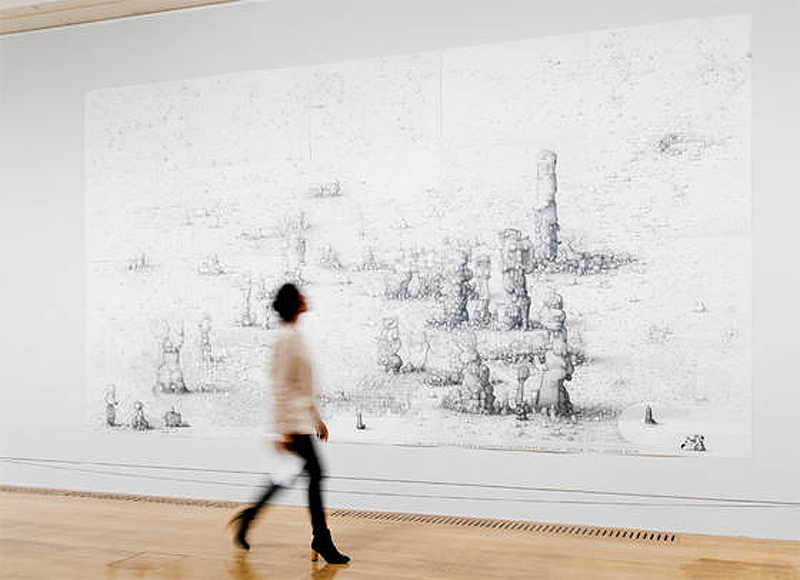
Some bird in daft boots striding with the confident air born of State Art insight; in the background, Villa Joe by Paul Noble, 2005
Having slipped into its tedious annual routine, the Turner Prize is upon us again, at Tate Britain, until January 6th; the winner – £25,000 better off – is announced to a live television audience of well into double figures on December 3rd. Those responsible for organising this banquet of self-congratulation continue to fanfare its importance, but it is in truth many years since the Turner Prize introduced an artist of any lasting significance whose work lives in the mind’s eye: it is a safe bet that in a hundred years no one will be looking at any of this work.
We have now had 27 years of the same ‘cutting edge’, for which lasting importance is routinely claimed; 27 years of ‘challenges’ forgotten almost immediately; 27 years of assorted ‘subversions’, ‘dissolvings’, ‘explorings’, ‘exploitings’ and ‘juxtaposings’ which have altered nothing; and at least a decade of winners whose names only half a dozen addicts of State Art can (or want to) remember. Cubism only took five years and even Impressionism was done for after ten.
We have reached the end of the avant garde. Without any locomotive power left, the gravy train is slowing down at the terminus, petering out with the buffers in sight, driven along at snail’s pace only by its own momentum and the willing shoulders of Serota’s lackeys. The Turner Prize is fucked, and only those involved with it can’t see the truth.
In the 18th century art was the preserve of aristocrats; in the 19th it was in thrall to industrialists; in the 20th it was all done for the benefit of the better educated; and in the 21st it was the exclusive domain of art students and others in a new art industry sustained by a tidal wave of taxpayer subsidy. So much for outreach.
And so to 2012 and the Buggin’s Turner Prize. As you would guess from her name, the person called Spartacus Chetwind is an ass. If she applied both brain cells to the task, and bought a very large cardboard comb, she might just qualify as an entertainer at children’s parties. “Her carnivalesque live events,” claims the Tate’s Chief Snake Oil Saleswoman, “dissolve the boundary between spectator and participant.” That’s so old hat: Quatermass did that sixty years ago.
As the work of a precocious undergraduate at a regional ‘university’ no one well educated has heard of, Luke Fowler’s photographs, in which any two pictures are spliced together in the hope of achieving a critical mass, might attract bollocksy exegesis from the resident theorist and intellectual. To the rest of us they add up first to bewilderment, and then nothing at all. But he’s not just a photographer isn’t our Luke. Oh no. He up for a spot of film-making too.
At a pinch it is painful but still possible to sit through a bad film by a Hollywood film director. However ponderous and leavened with noisy special effects, there will be at least some narrative drive to stop eyes drooping. On the other hand there is a bad film made by a Turner Prize nominee. This will be so inept it is unwatchable after three minutes, unless … unless you are lobbying for a salaried position in State Art – then, you must watch with exaggerated attention, take notes, nod knowingly at intervals and sit through it twice just in case the President-For-Life is spying on you for signs of apostasy. This is the case with Fowler’s 90-minute throatslitter about an interminable therapy session in the States. Any of the Prize’s judges who claims to have sat through this tripe, awake, from beginning to end is lying. It is many miles beyond a human being’s tolerance.
For those of a more conventional mindset Paul Noble makes large, detailed drawings of an imaginary place called Nobson Newtown, which has been exclusively absorbing his attention for 16 years. Like the work of Bosch and Dali, superficially the scenes look realistic but are fantastic panoramas containing no figures but, instead, are populated by totems not dissimilar to Henry Moore’s Glenkiln Cross. Scattered around the empty squares and expanses in between the ‘sculptures’ are a plague of what look like dog turds. Close up the graphite drawing is more laboured than expected, first impressions from a distance having suggested greater fluency. These pictures are dystopian, surreal curiosities and will take you longer to look at than the works by the other three contestants put together. This must constitute a sort of praise – it’s certainly a relief. His sculptures, carved presumably by someone else in black and white marble, are feeble, though doubtless easily saleable by Noble’s dealer Gagosian.
And that leaves Elizabeth Price who is represented by a 20-minute film called Woolworth’s Choir of 1979. Claimed by the aforementioned Chief Oiler to be “exploring the elastic potential of digital video”, it comes in three parts: views of an empty choir in a medieval church; clips of women disco dancers flinging their arms about; and footage of a fire in a furniture warehouse above Woolworth’s in Manchester’s Piccadilly. No obvious connection occurs between the three overlapping sections. As an experience, it is slow to unfold and ‘artistically’ repetitive; as in … “I’m repeating myself a lot, therefore I must be an artist”. Sadly, Woolworth’s is not incoherent with poetic possibilities, it is incoherent with incoherence.
David Lee
The Jackdaw, October 2012


